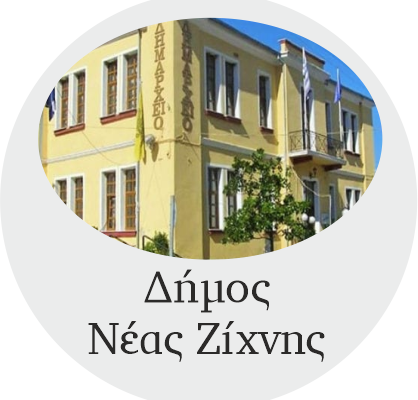The Municipality of New Zichni has a historical presence of more than 3,000 years. According to mythology, the Municipality of New Zichni was the headquarters of King Syleas, who oppressed the inhabitants by forcing them to cultivate his vineyards. It has even been said that Hercules had passed through this area, destroying the vineyards and killing the King.
The prehistoric tribes that settled in the area are the Paeons and the Thracians, who founded the following very important cities: Zichna, Zileia, Myrkinos, Iona, Gazoro, Dravisko, Ennea Odoi and Levithra. Samples of local coins minted at that time have survived to this day. After their conquest by the Macedonians (357 BC), a new Greek race arose, the Thracomacedonians, ancestors of the current local inhabitants.
The region was often targeted by many conquerors, due to the rich gold deposits on Mount Pangaio, the mines, the timber and also its proximity to the rivers Strymonas and Aggitis.
During the period of the Turkish occupation, the area turns into tsiflikia of beides and agades, the inhabitants are enslaved and a period of inactivity and stagnation begins. The constant massacres carried out mainly by Bulgarian conquerors, further weakened the inhabitants.
During the Macedonian War, the region trained brave warriors and heroes who contributed greatly to the liberation.
Although there were many who tried to conquer the area, the Christian element remained alive, as a proof of the faith of the inhabitants and the Byzantine Conquest. There are countless monuments (mainly monasteries) that prove the long Byzantine reign, such as the Virgin Mary Eikosifoinissa Holy Convent (built in honor of the Virgin in 450 AD), the Holy Monastery of the Ascension (built in the 18th century on a slope of Pangaio mountain), the Holy Monastery of Saint Paraskevi (built before 1474 AD), the Saint Minas Monastery and more.
However, the most important event that occurred in modern years is the settlement of Pontus and Asia Minor refugees in 1914 and 1922. A large percentage of today’s residents are descendants of these refugees, who were forced to leave their homelands and eventually settle in the New Zichni area to start a new life. These refugees greatly influenced the development of the wider region. They were mainly engaged in agriculture and trade, adopting new ways of farming and a new spirit in trading.
The thing that changed the Tracomacedonian region is the Asia Minor culture, with its customs, culinary tastes, distinctive language and education. All these are evidence that led to the designation of the area as a refugee.
Copyright 2023 © Created By Diadyktio, All Rights Reserved.
To provide the best experiences, we and our partners use technologies like cookies to store and/or access device information. Consenting to these technologies will allow us and our partners to process personal data such as browsing behavior or unique IDs on this site and show (non-) personalized ads. Not consenting or withdrawing consent, may adversely affect certain features and functions.
Click below to consent to the above or make granular choices. Your choices will be applied to this site only. You can change your settings at any time, including withdrawing your consent, by using the toggles on the Cookie Policy, or by clicking on the manage consent button at the bottom of the screen.

Congratulation!